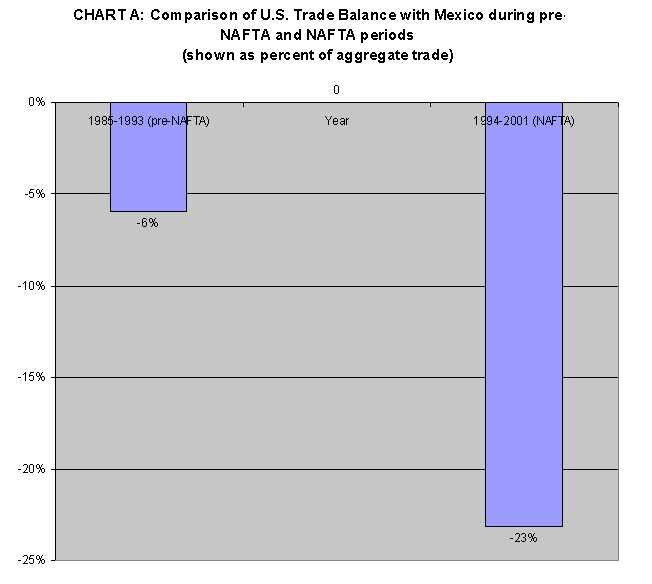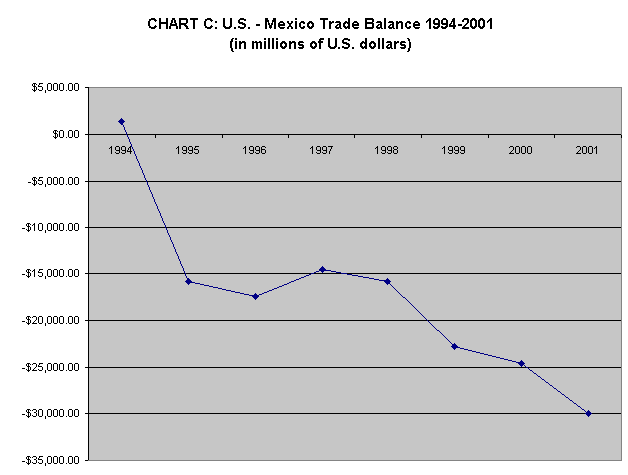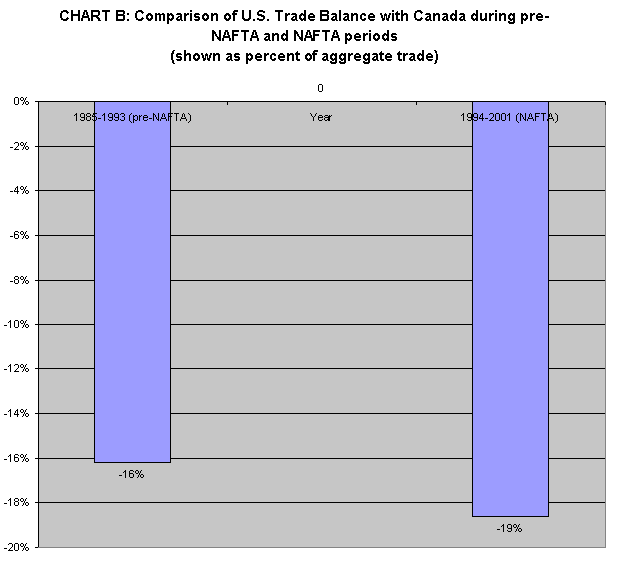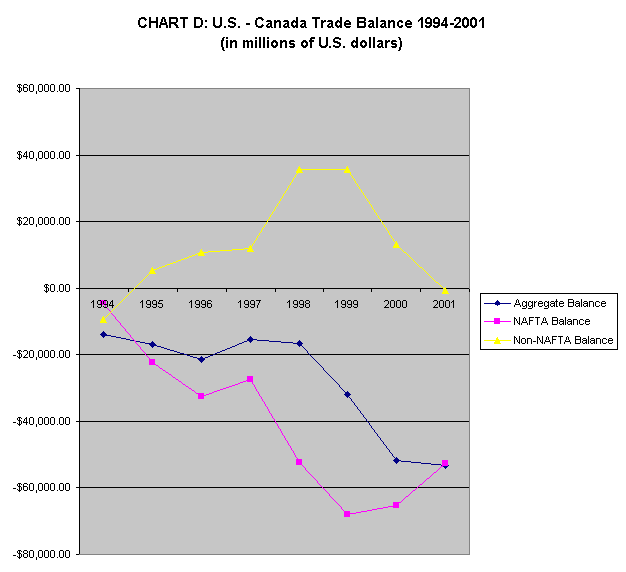|
Public
FTAA.soc/civ/39
June 10, 2002
Original: English
FTAA - COMMITTEE OF GOVERNMENT
REPRESENTATIVES ON THE PARTICIPATION
OF CIVIL SOCIETY
COVER SHEET FOR OPEN
INVITATION CONTRIBUTIONS
|
Name (s) |
William A.
Hagedorn |
|
Organization (s) |
Comstock & Theakston, Inc.
|
|
Country |
United States
|
NAFTA’s Implications for the Free
Trade Area of the Americas in regard to Trade, Labor and Duty Drawback
I . The effect of NAFTA on the
balance of trade in the United States
(All information in this section is
based on data obtained from the U.S. Census Bureau at their following
Internet locations:
http://www.census.gov/foreign-trade/balance/c1220.html
http://www.census.gov/foreign-trade/balance/c2010.html
http://landview.census.gov/foreign-trade/balance/c0006.html
http://landview.census.gov/foreign-trade/balance/c0005.html
.)
A. A comparison of the U.S.
balance of trade with Mexico during pre-NAFTA years (1985-1993) and
during the NAFTA years, to date (1994-2001)
CHART A: “Comparison of U.S.
Trade Balance with Mexico during pre-NAFTA and NAFTA periods” (below)
shows that during the 9 years before NAFTA was implemented, the
aggregate value of all goods that the U.S. imported from Mexico was 6%
greater than the aggregate value of all goods that the U.S. exported
to Mexico. In 1985 and 1986, the U.S. trade deficit with Mexico was
40%. Since then, the deficit lessened each year. During the years 1991
through 1993, the U.S. actually had a trade surplus with Mexico.
During the 8 years since NAFTA
has been implemented, the aggregate value of all goods that the U.S.
imported from Mexico was 23% greater than the aggregate value of all
goods that the U.S. exported to Mexico. In 1994, the first full year
that NAFTA was in effect, the U.S. still had a trade surplus with
Mexico, down slightly from 1993. However, in every year since then,
the U.S. has had a trade deficit with Mexico of at least 20%, going as
high as 34%.

CHART C: “U.S. - Mexico Trade Balance 1994-2001”
(below) provides additional detail regarding the trade deficits during
this 8-year period.


A comparison of the U.S. balance
of trade with Canada during pre-NAFTA years (1985-1993) and during the
NAFTA years, to date (1994-2001)
CHART B: “Comparison of U.S.
Trade Balance with Canada during pre-NAFTA and NAFTA periods” (below)
shows that during the 9 years before NAFTA was implemented, the
aggregate value of all goods that the U.S. imported from Canada was
16% greater than the aggregate value of all goods that the U.S.
exported to Canada. During the 11-year period from 1988 through 1998,
the trade deficit hovered between 7% and 16%. Since then, however, the
deficit has risen sharply, from 19% in 1999 to 29% in 2000 to 33% in
2001. The 37% deficit in January of 2002 is indicative of a continuing
trend toward higher trade deficits with Canada under NAFTA.
CHART D: “U.S. - Canada Trade Balance 1994-2001”
(below) provides additional detail regarding the trade deficits with
Canada during this 8-year period.

B. U.S. balance of trade with
Mexico, 1994-2001
Chart C illustrates the U.S.
trade balance with Mexico in terms of aggregate U.S. dollars. In 1994,
the first full year that NAFTA was in effect, the U.S. actually had a
trade surplus with Mexico of more than $1 billion. However, in 1995
the trade balance reversed dramatically as U.S. imports from Mexico
exceeded exports to Mexico by $15.8 billion. Since then, the trade
deficit has worsened every year with the exception of one (1997). The
trade deficit with Mexico grew to $29.9 billion in 2001; in January of
2002, that figure increased to more than $32 billion.
(Chart D, which illustrates the
aggregate U.S. trade balance with Canada, includes the subsets of
non-NAFTA and NAFTA transactions. Chart C, however, does not include
such subsets because the U.S. and Mexican governments do not exchange
data regarding U.S. exports into Mexico or Mexican imports from the
U.S.)
C. U.S. balance of trade with
Canada, 1994-2001
Chart D illustrates the U.S.
trade balance with Canada using three measurements: non-NAFTA trade,
NAFTA-specific trade and aggregate trade. This chart illustrates most
dramatically the counterproductive effect that NAFTA has had on the
U.S. trade balance with Canada.
NAFTA-specific transactions have
run consistent trade deficits for the U.S., from $4.4 billion in 1994
to $67.9 billion in 1999, averaging $40.6 billion annually over the
period.
Non-NAFTA transactions, in
contrast, provided the basis for an annual average surplus over
the period of more than $12.8 billion. (Industries and producers often
elect not to choose preferential treatment on their transactions
within NAFTA countries because valuation and classification processes
can be quite complex, and compliance with the rules in many cases
forces companies to set up expensive internal procedures that add to
the cost of their sales. Many would rather pay the tariff. Another
factor is the imposition of penalties when Certificates of Origin are
not completed correctly. It is significant to note that when companies
do not elect to choose preferential treatment on their transactions
within NAFTA countries, for whatever reason, that they are not under
NAFTA drawback restrictions, but instead can receive full
drawback (assuming eligibility, of course)).
The conclusion is inescapable:
NAFTA-specific transactions and non-NAFTA transactions have produced
markedly different results. NAFTA-specific transactions have resulted
in significant trade deficits for the U.S. year after year. Non-NAFTA
transactions (in which there is potential eligibility for full
drawback), in contrast, have tended to result in strong trade
surpluses. The reason why U.S. imports from Canada have
dominated exports to Canada in a NAFTA environment or why U.S. exports
to Canada have dominated imports from Canada in a non-NAFTA
environment cannot be conclusively deduced from the data. Keep in
mind, however, that products for which full drawback is refunded are
more profitable than products on which duty drawback is
restricted.
II. The effect of NAFTA on labor in
the United States
(Most of the information in this
section is based on data obtained from the Employment and Training
Administration of the U.S. Department of Labor. Their web page http://wdsc.doleta.gov/trade_act/taa/ntaa/asp/nafta.asp
is the starting point for accessing the data.)
The NAFTA-Transitional Adjustment
Assistance (NAFTA-TAA) Program was established under the North American
Free Trade Agreement Implementation Act of 1993. The NAFTA-TAA Program
combines aspects of two laws that have been in effect for many years:
Title I of the Workforce Investment Act (WIA) and the Trade Adjustment
Assistance (TAA) Program, under the Trade Act of 1974.
The NAFTA-TAA Program assists
workers who lose their jobs or whose hours of work and wages are reduced
as a result of trade with, or a shift in production to, Canada or
Mexico.
The NAFTA-TAA Program offers help
to workers whose companies have been directly or indirectly impacted as
a result of trade with or a shift in production to Canada or Mexico,
known as primary and secondary firms, respectively.
Primary firms are those adversely affected by trade with
Canada or Mexico, or who shift production to Mexico or Canada. Secondary
firms are those which supply materials to primary firms and/or assemble
or finish products of a primary firm.
In order for the U.S. Department
of Labor to issue a Certification Regarding Eligibility, the following
requirements must be met:
(1) that workers have been
totally or partially laid off, and
(2) that sales or productions
have declined, and
(3)
A) that increased
imports from Canada or Mexico have contributed importantly to worker
layoffs, or
B) that there has been a shift in production to Canada or
Mexico.
There have been almost 400,000
U.S. workers who have met the certification requirements listed above
(398,089 have been certified as of April 4,2002) with new petitions
being submitted and new certifications being issued on an ongoing basis.
This figure represents only workers involved in manufacturing jobs. It
does not represent all manufacturing workers whose jobs have been
affected or lost because of NAFTA, but only those who have applied for
assistance specifically through the NAFTA-TAA program. Nor does it
represent the total number of jobs affected or lost because of NAFTA,
because it does not include any service sector jobs. However, the fact
that it documents an actual number (albeit only partial) of jobs
affected or lost in the manufacturing sector as a result of
NAFTA is very significant.
The average manufacturing job in
the U.S. generates 4.5 times as many secondary service jobs as does the
average retail job, and 2.9 times as many secondary jobs as a job in the
personal and business service sector (Economic Policy Institute working
paper entitled “Employment Multipliers in the U.S. Economy”). In other
words, jobs in the manufacturing sector are significantly more valuable
to the long-term economic health of the U.S. economy than are other
types of jobs. However, as shown above and in the attached tables, it is
jobs in the manufacturing sector that are being eroded by NAFTA.
Therefore, we must pursue any change in trade policy that serves, at a
minimum, to maintain or protect these all-important manufacturing jobs
and even to restore, if possible, some of the hundreds of thousands that
have been lost as a direct result of NAFTA.
(Companies in every state have
been affected adversely by NAFTA. Note that the eligibility requirements
for assistance under the NAFTA-TAA Program, shown above, mandate that
not only must workers have been totally or partially laid off, as
detrimental as that is, but also that their company’s sales or
productions have declined.)
III. The Intent and the Result of
Restrictions on Duty Drawback in NAFTA
A. The Intent of Restrictions on
Duty Drawback in NAFTA
The legislative history of the
NAFTA Implementation Act states the following about the intention of
restricting duty drawback in NAFTA:
“Section 203, when fully
implemented, serves to remove the trade distorting provisions of the
drawback laws by placing restrictions on duty drawback on trade
between NAFTA countries. This is critical to ensure that none of
the NAFTA countries can become an "export platform" for materials
produced in other regions of the world.” [emphasis added]
Economists such as David Gantz at
the National Law Center for Inter-American Free Trade stated that is was
“evident that the lack of duty drawback treatment could be a powerful
incentive for [Mexico] to seek alternative sources of parts in the
future from North American rather than third country sources…This
could result in a significant diversion of trade from third countries
(e.g., Korea, Taiwan, Japan, India) to regional suppliers”. Furthermore,
“the parties wanted Mexico to be more than an export platform for
assembly industries. Increased sourcing of North American parts and
components was to be encouraged not only by rules of origin…but also
by elimination of duty waivers after a suitable grace period of seven
years. This grace period was designed to give Mexican factories
sufficient time to arrange for regional supplies to replace those from
non-NAFTA members. The combination of measures was designed to stimulate
foreign investment, create jobs, encourage technology transfer and give
U.S. firms facing prohibitive wage and other costs at home an
alternative to Asia.” (He also stated, however, that for some products,
the initial seven years under the agreement could be highly profitable,
since duty drawbacks would continue during that time.) [emphasis added]
J. Ernesto Lopez-Cordova (“NAFTA
and the Mexican Economy: Analytical Issues and Lessons for the FTAA”) in
discussing how NAFTA could influence the location of production in
Mexico, theorized that the eventual elimination of duty drawback
mechanisms (on January 1, 2001) would increase the incentives to move
intermediate good production to Mexico and North America. [emphasis
added]
B. Some dissenting opinions before
the implementation of NAFTA
Others foresaw different results,
however. The pending restrictions on duty drawback prompted major
industry and government concerns in Mexico that investment in the
maquila sector of the Mexican economy by non-NAFTA countries would fade
away as a result of the restrictions on duty drawback and duty deferral.
[The maquila sector of the
Mexican economy is largely focused on hereafter in this paper because
it is “probably the most important sector of the Mexican economy”
(editor, maquilaportal.com) and because of its unique situation of
having operated under the NAFTA statute both with unrestricted
drawback privileges (from 1994 through 2000) and with restricted
drawback (beginning on January 1, 2001).]
Likewise, many maquilas believed
that Article 303 of NAFTA, which would restrict duty deferral and duty
drawback programs, would cause them to lose their comparative advantage
because duty drawbacks would be phased out. They felt that the maquilas
would be integrated into the mainstream Mexican manufacturing industry.
C. Concern about the effect of
NAFTA Article 303 as January 1, 2001 approached
“The Impact of the 2001 NAFTA
Changes: Report to the U.S. Customs Service”, a report prepared for the
U.S. Customs Service under a contract with the National Center for
Inter-American Free Trade, made the following assertions:
“Developments which encourage
the maquiladoras to shift manufacturing operations to Asia have
potentially devastating impacts for the United States as well as for
Mexico. 75-80 percent of the content of maquiladora production
destined for the United States represents U.S. manufactured parts and
components. Should such factories be moved to Asia, it is reasonable
to assume that the U.S. content will drop substantially or disappear
entirely.”
“The duty waiver provisions that
were in place until January 1, 2001 have been a key feature of the
growth of the maquiladora program since the mid-1960s, and their
elimination will have enormous direct and indirect impact on these
firms and on the United States and Mexico.”
D. The Actual Results of
Restrictions on Duty Drawback in NAFTA
Diane Lindquist, a staff writer
for the San Diego Union-Tribune, writes the following in an article
entitled “Maquiladora Free Fall”, dated March 27, 2002:
“The year 2001 was by far the
worst in the 35-year history of Mexico’s maquiladora industry…”
“More than 238,000 positions
[20% of the total work force] were eliminated in Mexico’s maquiladora
sector as a whole.”
“As a result, some of the
maquiladora operators have shifted production to even lower-wage
countries such as China, Malaysia, Thailand, Ecuador, Guatemala and
Honduras.”
“And foreign investment - a
total of $2.17 billion - was off by almost $1 billion from the
previous year. In the last quarter of 2001, foreign investment in
maquiladora activities barely reached $500 million.”
“The industry experienced one of
its most significant growth spurts after the North American Free Trade
Agreement went into effect in 1994. But in 2001, as a result of NAFTA
provisions, Mexico eliminated the special tariff exemptions for
maquiladoras.”
“Economists estimate half the
maquiladora contraction is because of the U.S. economic downturn, a
third is related to the strong peso, and the rest is because of tax
and tariff revisions.”
On November 1, 2001 Dr. Luis
Ernesto Derbez, Mexico’s Secretary of Economy, discussed the state of
the maquiladora industry. He stated that in 2001 the maquiladora
industry would contract for the first time in fifteen years. He went on
to identify several factors that had contributed to the contraction of
the maquila industry. One of those was the changes to customs laws in
accordance with rule 303 of NAFTA. [“Foreign Desk Alert”, Ernst & Young,
11/15/2001]
In a news bulletin dated
04/29/2002 (maquilaportal.com) Javier Prieto de la Fuente, the president
of The Confederation of Industrial Councils (CONCAMIN), reported that 70
percent of the Mexican workers who lost their jobs in 2001 were from the
export manufacturing industry, and that it will take several years
before those jobs are replaced. He later stated that in spite of the
federal government’s efforts to strengthen export manufacturing, the
fruits of their work would not come for years. [emphasis added]
It is evident from the above facts
that the results of the duty drawback restrictions in NAFTA have had a
dramatically negative effect, totally the opposite of what the NAFTA
ministers had intended when they wrote the agreement and when the
respective countries signed it. Jobs have been lost, foreign investment
has dwindled, and production has moved out of the NAFTA countries and
into countries whose export platforms are more attractive because of
lower wages and the profitability of duty drawback.
IV. The remedial effect of duty
drawback
In Customs Headquarters Ruling
216658, the U.S. Customs Service states:
“In administratively
prescribing a method of identification for drawback, effect should
be given to the general purpose underlying the drawback law.
This purpose is to assist American business and labor to
compete more effectively in foreign markets by assuring that
whatever enters into the cost of doing business in such markets is
free from the additional cost of U.S. Customs duties. As a result,
-
U.S. export trade is
facilitated;
-
the balance of trade is
improved;
-
jobs are created;
and consequently
-
the general economy
thereby benefits
(see e.g., United States
v. International Paint Co., 35 C.C.P.A. 87, at 90 (1948)).
To this end, the drawback
law is remedial in character and should be construed to
accomplish the purpose intended (see Fenton Co. v. United States,
14 CCA 277, at 280 (1926))”. [emphases added]
The Court of Appeals for the
Federal Circuit, in Slip. Op. 99-1032, dated October 25, 1999, also
refers to “the remedial nature of the drawback statute”.
In Customs HQ Ruling 101421,
the U.S. Customs Service states in pertinent part:
“remedial statutes are those
which are designed to correct an existing law, redress an existing
grievance, or introduce regulations conducive to the public good”.
Although the NAFTA
Implementation Act was not in existence when the first duty drawback
statute was passed in 1789, the nature of the duty drawback statute
as a remedial law is very much applicable today again:
-
“to correct an existing law”
(e.g., NAFTA, or by implication to prevent proposed laws such as
the Free Trade Area of the Americas from including language, such
as restrictions to drawback, that would be counterproductive to
the U.S. balance of trade and to U.S. labor);
-
to “redress an existing
grievance” (e.g., the injurious effect that NAFTA has had on the
U.S. balance of trade and on the loss of manufacturing jobs in the
U.S.); and
-
to “introduce regulations
conducive to the public good”.
The statute and regulations
that would be conducive to the public good already exist in the form
of the drawback statute (19 U.S.C. 1313) and the drawback
regulations (19 CFR Part 191). What is needed is for this statute
and these regulations to have their full effect in order to
accomplish what they were intended to accomplish. In order for them
to have their full, remedial effect, free trade agreements must not
include provisions that restrict drawback. The existing duty
drawback statute and regulations must be allowed to stand on their
own. Language that puts restraints on drawback is not
necessary in a free trade agreement, nor is it beneficial to the
balance of trade or the strength of labor, especially in the
manufacturing sector.
Although this paper contains
information which could be deemed sufficient to question the very
basis of NAFTA itself and other future trade agreements that might
be modeled after it, nevertheless the scope of this paper is limited
to the subject of duty drawback and its potential remedial effect on
the U.S. trade deficit and the decline of manufacturing jobs in the
U.S. labor market. As stated in Customs Headquarters Ruling 216658
above, the duty drawback statute is intended to remedy the
disadvantageous effects of existing laws and to redress existing
grievances. This paper has demonstrated the direct correlation
between NAFTA and both the increase in the U.S. trade deficit with
Canada and Mexico and the decrease in manufacturing jobs and wages
in the U.S. It has also demonstrated that the intent of NAFTA to
ensure, by restricting duty drawback, that none of the NAFTA
countries could become an export platform for materials produced in
other regions of the world has not only not been realized, but has
been a significant factor in the sharp decline of the maquila
industry in Mexico. By removing the provisions for drawback from
NAFTA, all of which are restrictive of drawback, so that the
drawback statute as it exists independently from NAFTA is allowed to
have its full remedial effect, the following beneficial effects can
be expected:
-
U.S. export trade will
be facilitated;
-
the balance of trade
will be improved;
-
jobs will be created;
and consequently
-
the general economy will
thereby benefit.
It is understood, of course,
that duty drawback in and of itself does not have sufficient power
to turn the large trade deficit with Canada and Mexico into a trade
surplus, nor does it have, in and of itself, the ability to
completely reverse the erosion of manufacturing jobs such that all
the manufacturing jobs that have been lost or partially lost will be
restored. However, removing the drawback restrictions from NAFTA,
and not including them in the FTAA, thereby allowing the independent
duty drawback statute to have its full effect, will have some
positive effect, to whatever degree, on the balance of trade and the
labor situation, especially in the manufacturing sector.
In 1995 and 1996, several
versions of the NAFTA Accountability Act were introduced in
Congress, an act that would have applied a “do no further harm” test
to NAFTA. Because that act did not become law, it is imperative that
we now take any possible actions that would at least slow down the
damaging effects that NAFTA has had on the trade balance and labor
for more than 8 years to date. One of those actions would be the
removal of the drawback provisions from NAFTA. Another would be to
make sure that the FTAA does not include language that would
restrict drawback and its positive effects, effects that have been
attested for more than 200 years by the U.S. Congress, U.S. courts,
and recently even the World Trade Organization (WTO). (The WTO has
described some of the effects of drawback programs in countries
around the world as follows: “exports benefited”; “exporters
benefit”; “export incentive”; “counteracts the negative effects of
high import tariffs”; “a strong magnet for export-oriented foreign
direct investment”; “exports encouraged”; “manufactured goods
benefit”; and “removes a bottleneck to private sector development”.)
V. Conclusions
A. The section on duty drawback
(Sec. 203. DRAWBACK) should be removed from the NAFTA
Implementation Act (Public Law No. 103-182); and
B. The subject of duty drawback
should not be included in the Free Trade Area of the
Americas (FTAA).
NAFTA substituted its own
restrictive drawback program for the one that had proven its value
to the U.S. for over 200 years. If the FTAA forces the member
parties to abandon their drawback programs, and to substitute for
them a restrictive one such as in NAFTA, it would be difficult, at
best, to find any advantage to such a decision. A free trade
agreement, as most of the existing ones state directly in their
preambles or introductions, intend to provide conditions that are
advantageous for each of the parties in that agreement.
Therefore, the FTAA negotiators should seriously consider the
negative effects that NAFTA, with its restrictive duty drawback
provisions, has had on the U.S. balance of trade and labor, and on
the decline of Mexico’s maquila program.
The best and easiest way for
each country to obtain the most advantageous effect is simply not
to include any provisions concerning duty drawback in the Free Trade
Area of the Americas. This will allow the existing duty drawback
programs for each country to function independently of the free
trade agreement, and therefore to achieve the maximum beneficial
impact that they were intended to have and which they in fact have
had.
|
